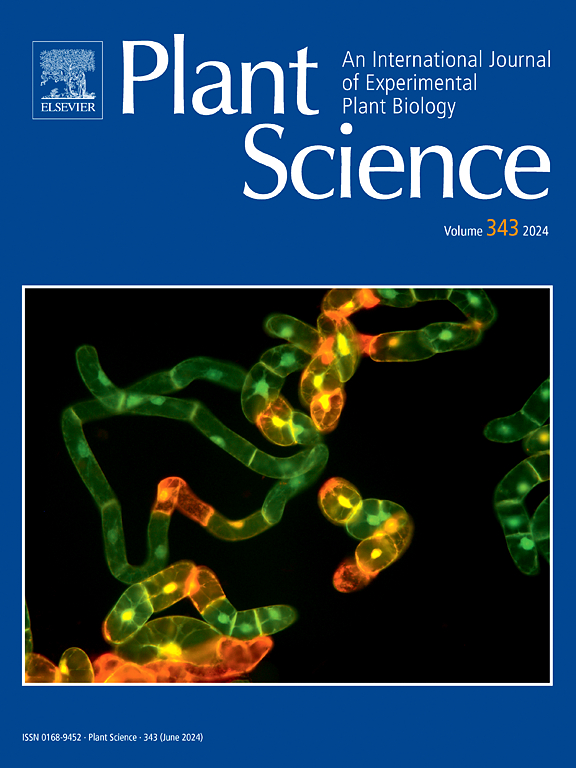Genomic insights into assembly of α-β hydrolase superfamily genes involved in blast resistance in rice
IF 4.2
2区 生物学
Q2 BIOCHEMISTRY & MOLECULAR BIOLOGY
引用次数: 0
Abstract
The α-β hydrolase (ABH) gene encodes growth, development, and stress-associated enzymes in various plants; however, its evolution and function in cereal crops remain largely unexplored. In this study, bioinformatics analysis was performed to define and predict OsABH superfamily evolution and function in Oryza indica. Then transgenic rice plants overexpressing the OsABH superfamily gene BGIOSGA016507 were generated, and the expression dynamics of disease resistance factors in response to Magnaporthe oryzae infection were assessed using RT-qPCR. Meanwhile, endogenous hormones levels were quantitatively determined through ELISA. Results indicated that 41 ABHs were identified in O. indica. Interspecies synteny analysis revealed that OsABH shared the highest number of syntenic gene pairs with TaABH (86 pairs), compared to only 10 pairs with AtABH, suggesting the closest evolutionary relationship between the OsABH superfamily in O. indica and Triticum aestivum. These findings also indicated that the OsABH superfamily amplification is linked to segmental duplications. Besides, the OsABH promoter exhibited multiple biotic and abiotic stress and tolerance-associated cis-acting elements. BGIOSGA016507 haplotypes analysis showed an obvious indica bias. Additionally, BGIOSGA016507 responded to rice blast stress. Compared to wild-type Nipponbare, the OE-016507 showed significantly smaller lesion areas post M. oryzae inoculation (P < 0.001). Concurrently, significant differences were observed in PRs expression and endogenous hormones levels, with salicylic acid reaching a peak concentration of 228.75 pmol/L at 36 hpi, approximately twice the level detected in NPB. This study sheds light on the understanding of ABH superfamily evolution in rice and validates OsABH involvement in blast-resistant response.
水稻抗稻瘟病α-β水解酶超家族基因组装的基因组研究。
α-β水解酶(ABH)基因在多种植物中编码生长、发育和胁迫相关酶;然而,它在谷物作物中的进化和功能在很大程度上仍未被探索。本研究通过生物信息学分析来定义和预测水稻OsABH超家族的进化和功能。然后构建过表达OsABH超家族基因BGIOSGA016507的转基因水稻植株,利用RT-qPCR技术评估水稻侵染Magnaporthe oryzae后抗病因子的表达动态。同时,通过ELISA法定量测定内源激素水平。结果表明,在籼稻中共鉴定出41种ABHs。OsABH与TaABH共有的基因对数最多(86对),而与AtABH共有的基因对数只有10对,表明OsABH超家族在籼稻和小麦中进化关系最为密切。这些发现还表明OsABH超家族扩增与片段重复有关。此外,OsABH启动子具有多种生物和非生物胁迫和耐受性相关的顺式作用元件。BGIOSGA016507单倍型分析显示明显的指标偏倚。此外,BGIOSGA016507对稻瘟病胁迫有响应。与野生型日本裸鼠相比,OE-016507接种M. oryzae (P
本文章由计算机程序翻译,如有差异,请以英文原文为准。
求助全文
约1分钟内获得全文
求助全文
来源期刊

Plant Science
生物-生化与分子生物学
CiteScore
9.10
自引率
1.90%
发文量
322
审稿时长
33 days
期刊介绍:
Plant Science will publish in the minimum of time, research manuscripts as well as commissioned reviews and commentaries recommended by its referees in all areas of experimental plant biology with emphasis in the broad areas of genomics, proteomics, biochemistry (including enzymology), physiology, cell biology, development, genetics, functional plant breeding, systems biology and the interaction of plants with the environment.
Manuscripts for full consideration should be written concisely and essentially as a final report. The main criterion for publication is that the manuscript must contain original and significant insights that lead to a better understanding of fundamental plant biology. Papers centering on plant cell culture should be of interest to a wide audience and methods employed result in a substantial improvement over existing established techniques and approaches. Methods papers are welcome only when the technique(s) described is novel or provides a major advancement of established protocols.
 求助内容:
求助内容: 应助结果提醒方式:
应助结果提醒方式:


